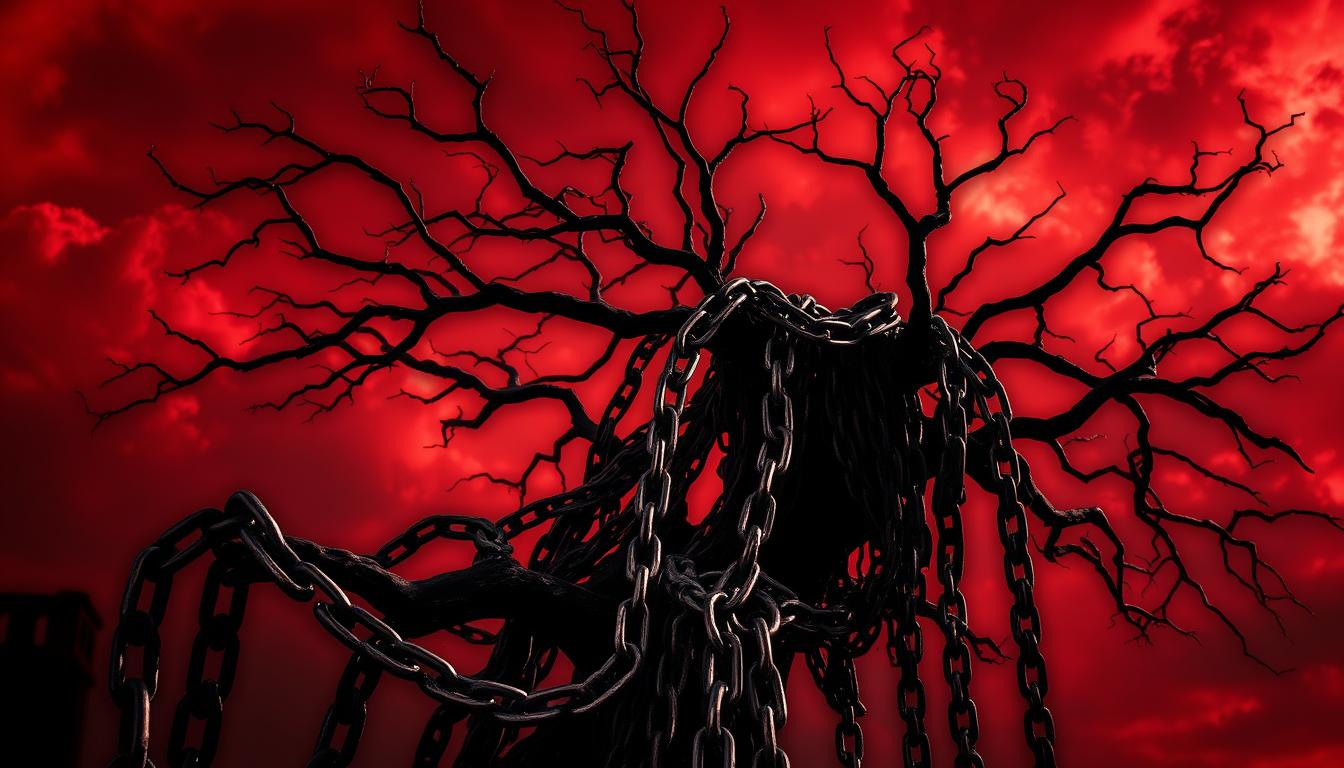Symbolizing bondage and temptation, The Devil tarot card often reveals hidden traps in life. It serves as a mirror, reflecting areas where individuals feel chained—whether by addiction, toxic relationships, or self-sabotage. Understanding its message can be a powerful tool for liberation.
This guide decodes warnings embedded in the card, offering actionable strategies to break free. While it highlights entrapment, it also presents growth opportunities. By confronting these “chains,” individuals can reclaim their power and transform their world.
Real-world examples, like addiction or unhealthy habits, illustrate the card’s relevance. Historical roots and psychological insights further deepen its meaning. This article explores how to navigate its dual nature—turning warnings into pathways for personal growth.
Key Takeaways
- Understand symbolism of The Devil tarot card in revealing hidden traps.
- Learn how to decode its warnings for personal liberation.
- Explore dual nature: entrapment vs. growth opportunities.
- Identify real-world “chains” like addiction or toxic relationships.
- Gain actionable strategies to reclaim power and transform life.
Introduction to The Devil Tarot Card
Rooted in symbolism, it reflects humanity’s battle with inner demons. This card, often misunderstood, serves as a mirror to our deepest challenges. Its imagery, featuring chained figures and an inverted pentagram, uncovers the chains of entrapment we face daily.
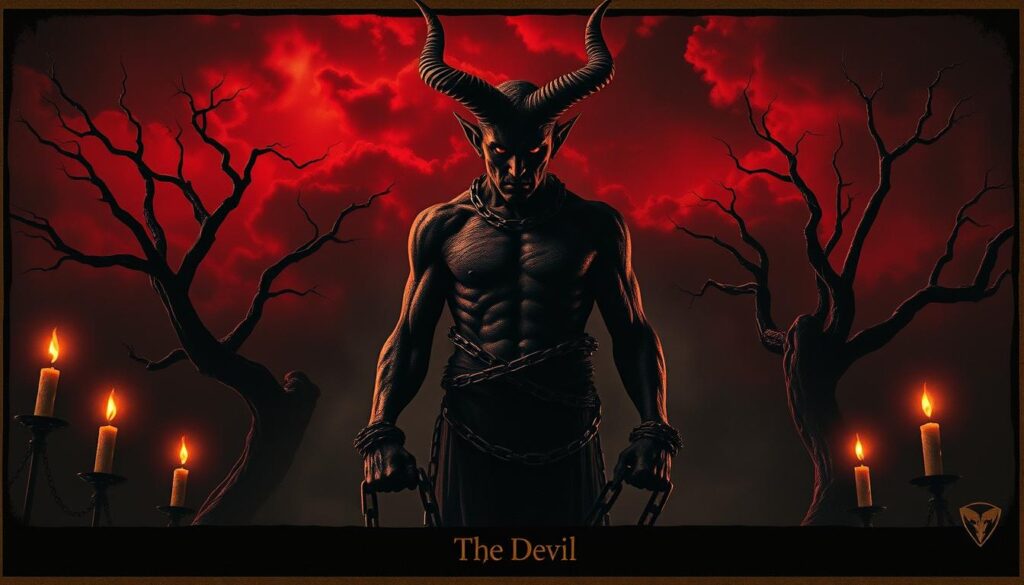
Positioned as #15 in the Major Arcana, it follows Temperance, highlighting a shift from balance to temptation. Medieval interpretations viewed it as evil incarnate, while modern readings focus on psychological struggles. Understanding its meaning can lead to personal growth.
Symbol of Temptation
Its imagery often symbolizes evil and temptation. The chained figures represent addiction and powerlessness, while the inverted pentagram signifies the dominance of material desires. Baphomet, the horned figure, embodies humanity’s lower nature.
A 2023 Tarot Reader Survey revealed that 68% associate this card with breaking cycles. This aligns with C.G. Jung’s shadow work, emphasizing the need to confront inner struggles for transformation.
Significance in Readings
In tarot readings, it highlights areas where individuals feel trapped. Whether by addiction, toxic relationships, or self-sabotage, it urges self-awareness. Contrasting with angels, it represents humanity’s lower nature, urging us to reclaim our power.
The card’s creation reflects medieval symbolism, yet its relevance persists today. By decoding its warnings, individuals can turn entrapment into pathways for growth. This duality makes it a powerful tool for personal liberation.
The Historical Roots of The Devil
From mythology to religious texts, the archetype of temptation has deep roots. Ancient cultures often depicted figures representing chaos and desire, which later influenced modern interpretations. These narratives shaped the symbolism we see in tarot today.
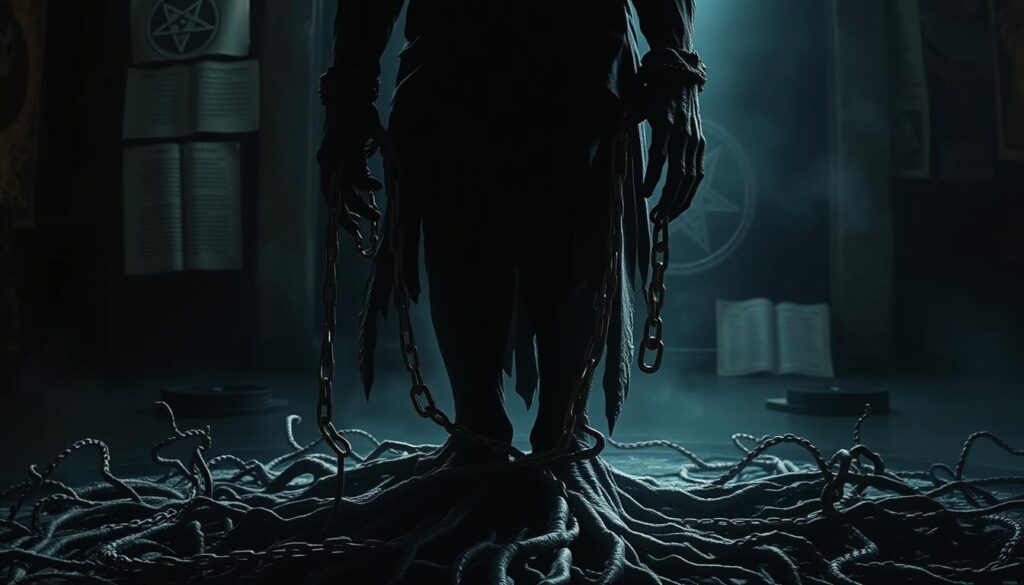
From Ancient Mythology to Tarot
Greek mythology introduced Pan, a horned god symbolizing nature and desire. This imagery evolved into the Baphomet figure seen in tarot. Similarly, Babylonian myths like the Enuma Elish featured chaos monsters, paralleling the Great Red Dragon in Revelation.
By the 15th century, printing technology standardized these depictions. Dante’s Inferno further cemented the horned figure in Western culture. These influences merged to create the tarot’s iconic imagery.
Religious Texts and the Archetype
Religious books and chapters also shaped the concept. Ezekiel 28:13-15 describes a fallen angel, while the Quran’s Iblis refused to bow to Adam. Zoroastrianism’s Angra Mainyu, representing chaos, influenced Abrahamic traditions.
Martin Luther’s personal struggles with temptation added a human dimension to the archetype. These stories highlight the enduring relevance of the figure in exploring human weakness and creation of moral boundaries.
Symbolism Behind The Devil Card
Hidden within its design are clues to understanding personal entrapment. This card’s imagery speaks volumes about the ways we bind ourselves to unhealthy patterns. From chains to figures, every element holds a deeper meaning.
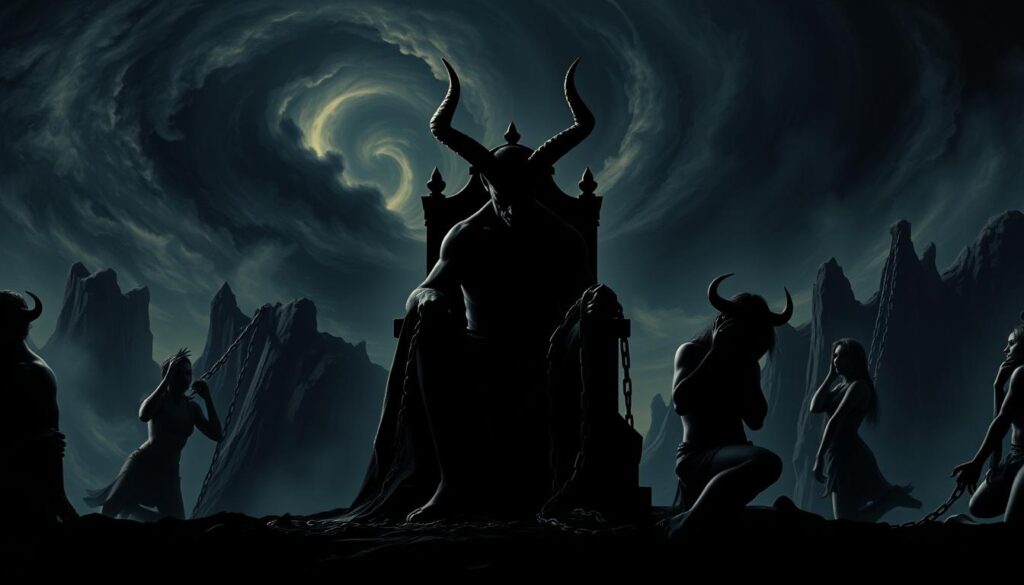
The Chains of Bondage
Chains in the card symbolize self-imposed limitations. Loose links suggest a chance for liberation, while tight ones indicate deeper entrapment. These bonds often represent addiction, toxic relationships, or fear.
In the Rider-Waite-Smith deck, chains are prominent, emphasizing the struggle for freedom. The Thoth deck, however, uses subtler imagery, focusing on psychological bondage. Both styles highlight the need for self-awareness.
The Figures of Adam and Eve
The man and woman figures, often linked to adam eve, represent humanity’s dual nature. Their presence reflects the temptation of forbidden desires, much like the serpent in biblical stories.
Eve’s connection to the apple symbolizes knowledge and the allure of the unknown. Modern reinterpretations, like the LGBT+ tarot’s “Liberation Devil,” expand this symbolism to include diverse struggles.
The Horned Figure and Its Meaning
The horned figure, often seen as a creature, embodies temptation and materialism. Its inverted pentagram, linked to 16th-century witch trials, represents the dominance of earthly desires.
Jungian archetypes further explain this figure as a representation of humanity’s shadow side. Confronting this “horned god” can lead to profound personal growth.
| Symbol | Meaning |
|---|---|
| Chains | Self-imposed limitations, addiction, fear |
| Adam and Eve | Humanity’s dual nature, temptation |
| Horned Figure | Materialism, shadow self, temptation |
The Devil in Tarot Readings
In tarot readings, this card often sparks fear, but its message is more nuanced than it seems. It highlights areas where individuals feel trapped, whether by addiction, toxic relationships, or self-sabotage. Understanding its dual nature can turn warnings into pathways for growth.
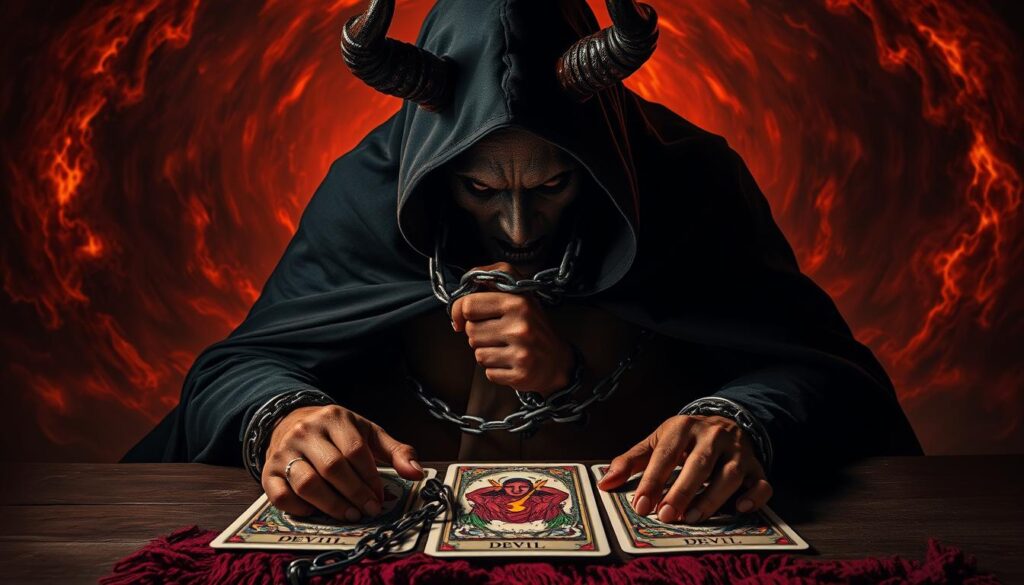
Upright vs. Reversed Interpretations
When upright, it signifies obsession, materialism, and unhealthy attachments. It’s a call to examine what’s holding you back. As 1 Peter 5:8 states,
“Be alert and of sober mind. Your enemy prowls like a roaring lion looking for someone to devour.”
This reflects the card’s warning about temptation.
Reversed, it symbolizes breaking free and reclaiming power. It’s a sign of shadow integration, where individuals confront their inner struggles. Modern Wicca often reinterprets such figures as nature spirits, emphasizing transformation over fear.
Common Misconceptions About The Devil
Many believe this card is always negative, but 42% of professional readers report positive outcomes. It doesn’t predict catastrophe; instead, it highlights areas needing change. Another myth is its religious condemnation, but its meaning extends beyond traditional beliefs.
Compared to other “scary” cards like The Tower or Death, it offers a balanced perspective. It’s not about good evil but about recognizing and overcoming personal limitations. By the end of a reading, it often serves as a wake-up call for transformation.
The Psychological Impact of The Devil Card
Delving into the psychological layers, this card reveals the battle between our desires and self-control. It’s a mirror to the inner struggles that shape our actions and decisions. By understanding its symbolism, we can uncover pathways to self-awareness and growth.
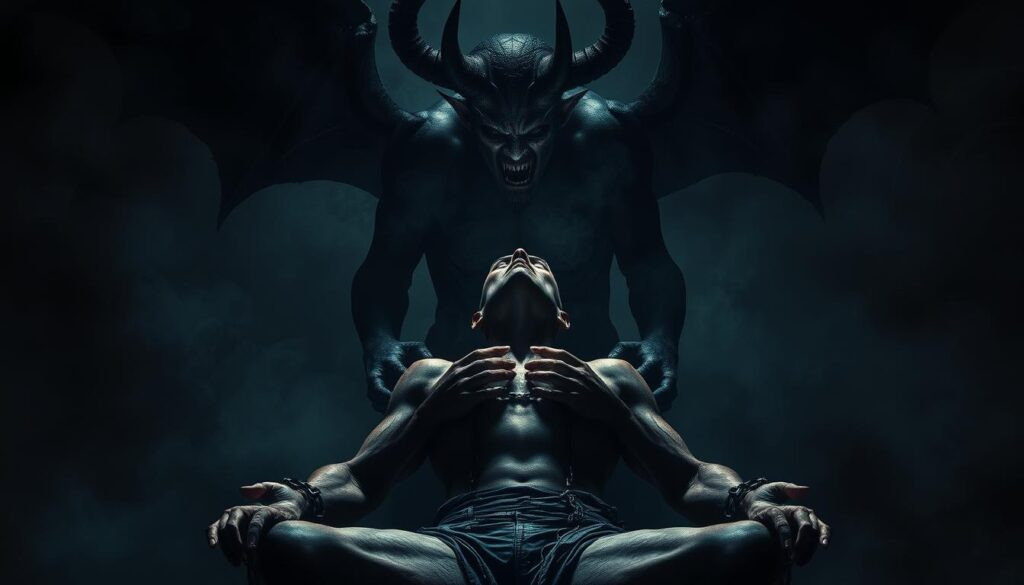
How It Reflects Inner Struggles
This card often highlights the tension between the id and superego. Freud’s theory explains how our primal desires clash with moral standards. The imagery of chains and bondage reflects this internal conflict, showing how we can feel trapped by our own impulses.
For example, the Stanford Marshmallow Experiment illustrates delayed gratification. It’s a powerful parallel to the card’s message about resisting temptation. People who master self-control often find greater success and fulfillment in life.
The Role of Fear and Desire
Fear and desire are central to this card’s meaning. Fear keeps us chained to unhealthy patterns, while desire drives us toward instant gratification. Understanding this duality can help us break free from negative cycles.
Modern comparisons, like dopamine loops in social media, show how easily we can become addicted to quick rewards. Recognizing these patterns is the first step toward reclaiming control.
- Addiction Psychology: Prochaska’s stages of change model helps identify where we are in overcoming harmful habits.
- CBT Therapy: Reflecting on this card’s symbolism can lead to breakthroughs in cognitive behavioral therapy.
- Brené Brown’s Research: Embracing vulnerability, as Brown suggests, aligns with the card’s call for authenticity.
- Journal Prompts: Questions like “What fears hold me back?” can guide self-assessment and growth.
“Vulnerability is the birthplace of innovation, creativity, and change.” – Brené Brown
By confronting our inner struggles, we can transform fear into strength. This card reminds us that liberation is always within reach, if we’re willing to face our shadows.
The Devil and the Concept of Good vs. Evil
Exploring duality, this card challenges our understanding of right and wrong. It’s not just about good evil but the gray areas in between. Throughout history, thinkers have debated this concept, shaping how we view morality today.
Manichaeism, an ancient religion, introduced dualistic cosmology. It saw the world as a battleground between light and darkness. This idea influenced tarot, where duality is a recurring theme. Thomas Aquinas, in his Summa Theologica, defined evil as the absence of good. His word still resonates in modern philosophy.
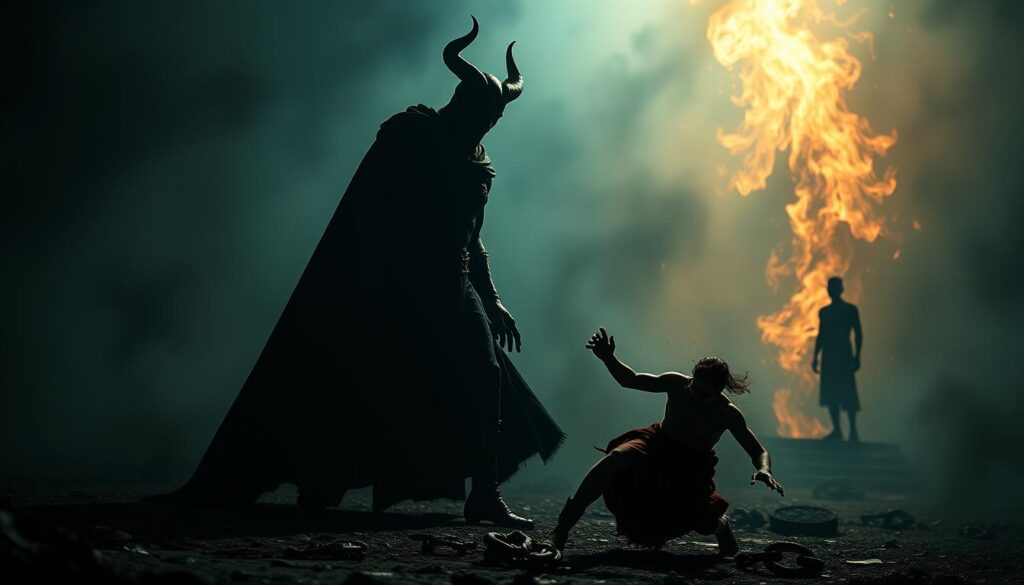
Zoroastrianism contrasts sharply with Buddhist non-duality. While Zoroastrians see a clear divide between Ahura Mazda (good) and Angra Mainyu (evil), Buddhists focus on ethical behavior beyond binary thinking. This shows how cultures interpret duality differently.
John Milton’s Paradise Lost portrays Satan as a tragic figure. His human qualities make him relatable, blurring the lines between hero and villain. This literary masterpiece invites us to question traditional notions of morality.
Modern neuroethics explores moral decision-making through brain scans. Studies reveal how our brains process right and wrong. Similarly, cancel culture reflects the polarization of good evil in today’s society. Both highlight the complexity of human judgment.
“Evil is the absence of good, just as darkness is the absence of light.” – Thomas Aquinas
Beyond binary thinking, some traditions introduce a “third way.” The Baháʼí Faith, for example, sees evil as a lack of good, not an opposing force. This perspective encourages us to seek balance rather than division.
| Tradition | Perspective on Good vs. Evil |
|---|---|
| Manichaeism | Dualistic, light vs. darkness |
| Buddhism | Non-dual, focus on ethics |
| Zoroastrianism | Clear divide between good and evil |
| Baháʼí Faith | Evil as absence of good |
This card reminds us that morality isn’t black and white. By embracing complexity, we can move beyond binary thinking and find deeper truths. Whether through literature, religion, or science, the concept of duality continues to shape our world.
Breaking Free From The Devil’s Chains
Liberation from entrapment begins with self-awareness and actionable steps. Whether it’s addiction, toxic relationships, or self-sabotage, recognizing these patterns is the first step toward reclaiming power. Viktor Frankl’s logotherapy emphasizes finding meaning even in challenging situations, which aligns with this process.

WHO’s 2023 burnout classification highlights the importance of addressing mental and emotional exhaustion. This mirrors the card’s message about breaking free from cycles that drain our energy. By integrating these insights, individuals can transform their life and move toward healthier habits.
Recognizing Toxic Patterns
Identifying what holds us back is crucial. Whether it’s fear, addiction, or unhealthy routines, these patterns often operate beneath the surface. Tools like habit trackers or shadow work journals can help uncover these hidden chains.
Circadian rhythms also play a role. Aligning daily routines with natural energy cycles can make it easier to break free from negative habits. For example, a Fortune 500 executive used insights from this card to pivot their career, demonstrating its practical applications.
Steps to Reclaim Your Power
Reclaiming control involves a structured approach. A 5-step detox plan—Identification, Accountability, Replacement, Integration, and Maintenance—provides a clear path forward. Replacing negative habits with positive ones is key to lasting change.
Energy healing techniques, like Reiki cord-cutting visualizations, can also support this process. These methods help release emotional and energetic ties to past traumas or toxic relationships.
“Between stimulus and response, there is a space. In that space is our power to choose our response.” – Viktor Frankl
By taking intentional steps each day, individuals can break free from entrapment and move toward a more fulfilling life. This journey requires patience, but the rewards are worth the effort.
The Devil in Love and Relationships
Love and relationships often reveal our deepest vulnerabilities. They can be a mirror, reflecting both our strengths and the chains that bind us. Understanding these dynamics helps us navigate emotional entrapments and build healthier connections.
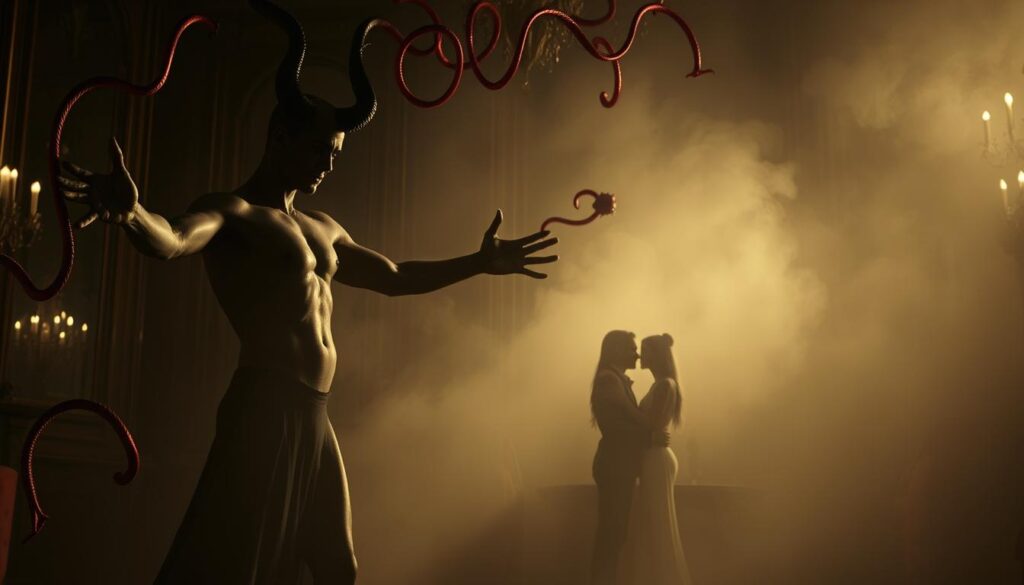
Attachment theory explains how anxious or preoccupied patterns can trap us in unhealthy cycles. For example, a man might cling to a partner out of fear of abandonment. Recognizing these patterns is the first step toward breaking free.
Gottman Institute’s “Four Horsemen” of conflict—criticism, contempt, defensiveness, and stonewalling—highlight toxic behaviors that harm relationships. Addressing these can transform conflict into connection.
Here are three red flags to watch for in relationships:
- Possessiveness: Controlling behavior that limits freedom.
- Enmeshment: Losing individuality in a relationship.
- Trauma Bonding: Staying attached due to shared pain.
Contrasting toxic passion with healthy intimacy is crucial. Sternberg’s Triangle of Love identifies three components: intimacy, passion, and commitment. Balancing these creates lasting bonds.
For LGBTQ+ relationships, overcoming internalized shame is a common challenge. Embracing authenticity fosters deeper connections. In the digital age, challenges like porn addiction and emotionally unavailable partners add complexity to modern love.
“Love is not about possession. It’s about appreciation.” – Unknown
One couple’s story illustrates this transformation. After drawing The Devil card in a reading, they confronted their toxic patterns. Through therapy and self-awareness, they renewed their vows, stronger than ever.
| Relationship Challenge | Solution |
|---|---|
| Possessiveness | Encourage independence and trust |
| Enmeshment | Foster individuality and boundaries |
| Trauma Bonding | Seek therapy and healing |
By addressing these challenges, humans can transform their relationships. Love becomes a source of growth, not entrapment. Whether it’s overcoming shame or breaking free from digital distractions, the journey is worth it.
The Devil in Career and Finances
Career and finances often reflect the chains we bind ourselves to, whether through fear, ambition, or societal pressure. These “chains” can manifest as golden handcuffs, toxic hustle culture, or even the allure of quick wealth. Recognizing them is the first step toward reclaiming power over your professional and financial life.
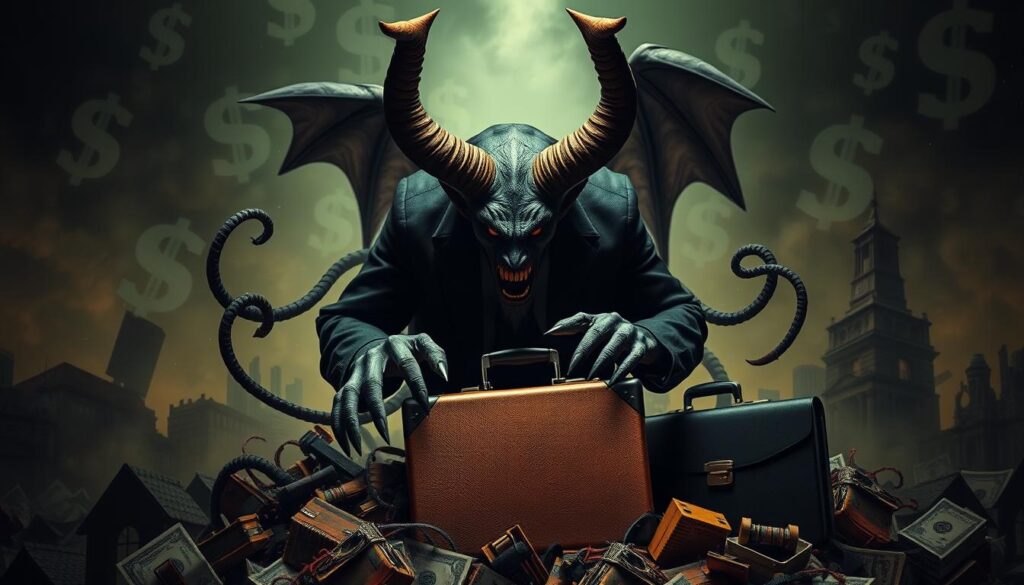
Corporate environments are rife with entrapments. Golden handcuffs—high salaries tied to soul-crushing work—keep many stuck. Toxic hustle culture glorifies overwork, leading to burnout. The Great Resignation and quiet quitting phenomena highlight a growing desire to break free from these cycles.
The FIRE movement (Financial Independence, Retire Early) offers a modern path to liberation. By prioritizing savings and investments, individuals can escape the rat race. A tech worker’s story illustrates this: after earning $300k annually but feeling empty, they downsized their lifestyle and pursued passion projects, finding fulfillment beyond material gains.
Crypto speculation has become a new form of entrapment. Like traditional gambling, it promises quick riches but often leads to financial ruin. Regulatory strategies, such as the SEC whistleblower programs, aim to protect investors by exposing unethical practices. These efforts mirror the card’s call for accountability and self-awareness.
“Financial freedom is not about how much you earn, but how much you keep and how you use it.” – Unknown
Breaking free requires intentional steps. Start by identifying what holds you back. Is it fear of failure? Societal expectations? Next, create a plan to replace negative patterns with healthier ones. Whether it’s pursuing financial independence or aligning your career with your values, the journey is worth the effort.
By the end of this process, you’ll find that liberation is not just about escaping entrapment but about creating a life aligned with your true desires. The world of career and finances is vast, and with the right mindset, you can navigate it with confidence and purpose.
Spiritual Lessons From The Devil Card
Spiritual growth often requires confronting our deepest fears and desires. This card serves as a mirror, reflecting the shadows we must face to evolve. By understanding its lessons, we can transform darkness into wisdom.
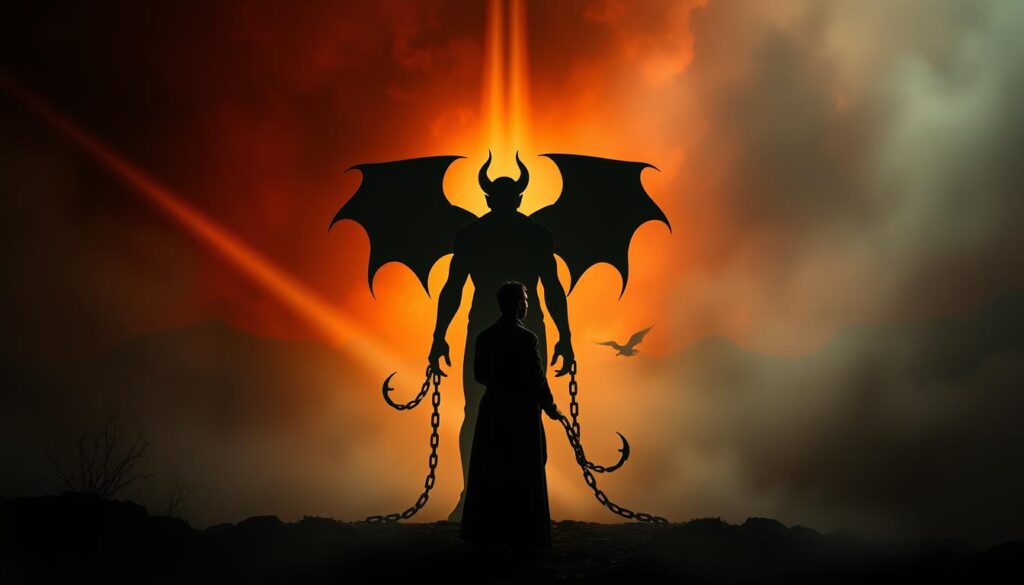
In Kabbalah, the Qliphoth shadow tree represents materialism and carnal desires. These correspondences highlight how the card symbolizes entrapment in lower vibrations. Similarly, the Hindu concept of Maya teaches that reality is an illusion, often fueled by unchecked desires.
Alchemical transformation offers a powerful metaphor. Turning lead into gold symbolizes elevating base desires into higher purpose. This process mirrors the card’s call to transcend materialism and embrace spiritual creation.
- Shamanic Soul Retrieval: Reclaiming fragmented parts of the self to heal and integrate.
- Dark Night of the Soul: A period of inner turmoil leading to profound transformation.
- Zen Koans: Paradoxical teachings that encourage a new way of thinking.
- Root Chakra Blockages: Addressing survival fears to restore balance.
Energy anatomy reveals how root chakra blockages manifest as fear and scarcity. By healing these, we can break free from survival instincts. This aligns with the card’s message of liberation.
“The only way out is through.” – Robert Frost
For those seeking deeper insights, resources like Hannah Brites offer guidance on navigating spiritual challenges. By embracing these lessons, we can transform our day-to-day struggles into opportunities for growth.
| Spiritual Practice | Lesson |
|---|---|
| Alchemy | Transform base desires into higher purpose |
| Shamanism | Heal fragmented selves |
| Zen | Embrace paradoxical thinking |
| Energy Healing | Address root chakra blockages |
Ultimately, this card reminds us that confronting our shadows is a necessary step toward enlightenment. By integrating these lessons, we can move beyond illusions and embrace our true selves.
Practical Rituals to Counteract The Devil’s Influence
Practical rituals can transform fear into empowerment, breaking free from entrapment. These practices, rooted in mindfulness and intentionality, offer pathways to reclaiming personal power. Whether through meditation, affirmations, or community ceremonies, these rituals help dismantle negative influences and foster liberation.
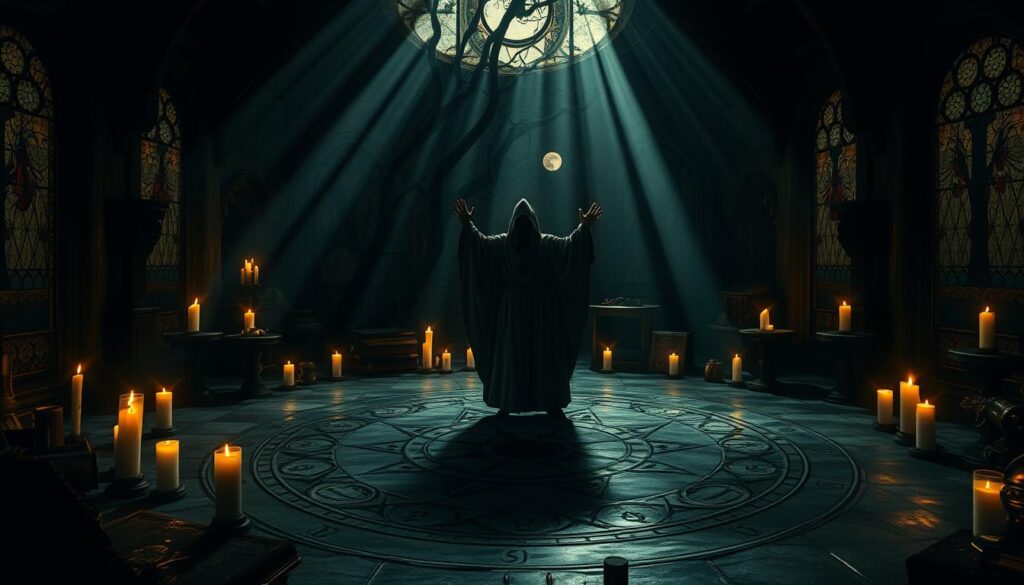
Meditation and Visualization
Meditation is a powerful tool for breaking free from mental chains. Studies from the NIH show that mantra repetition reduces cortisol levels, promoting calm and clarity. Visualization, enhanced by VR meditation apps, allows individuals to imagine themselves free from entrapment.
Here’s a simple meditation practice to try:
- Find a quiet space and sit comfortably.
- Close your eyes and focus on your breath.
- Visualize chains breaking away, symbolizing liberation.
- Repeat a mantra like “I am free” to reinforce the experience.
Using Affirmations to Break Free
Affirmations are statements that reprogram the mind, replacing negative thoughts with empowering ones. Neuroscience research supports their effectiveness in rewiring the brain for positivity. Crafting personalized affirmations can help individuals reclaim their life and break free from limiting beliefs.
Seven powerful affirmations to consider:
- “I release what no longer serves me.”
- “I am worthy of love and freedom.”
- “My word has the power to create change.”
- “I embrace my inner strength.”
- “I am free from fear and doubt.”
- “I choose joy and abundance.”
- “I am aligned with my highest purpose.”
Integrating biohacking techniques, like red light therapy, can amplify the effects of affirmations. This combination supports both physical and emotional healing.
Community Rituals for Collective Healing
Community rituals, such as Burning Bowl ceremonies, offer collective support in breaking free from entrapment. These practices involve writing down limiting beliefs or fears and burning them as a symbolic release. Timing rituals with the waning crescent moon enhances their effectiveness, aligning with natural cycles of release.
“Rituals are the roadmaps to transformation.” – Unknown
| Ritual Type | Purpose |
|---|---|
| Meditation | Promotes calm and clarity |
| Affirmations | Reprogram the mind for positivity |
| Community Ceremonies | Foster collective healing |
By incorporating these rituals into daily life, individuals can break free from entrapment and move toward a more fulfilling existence. The journey requires patience, but the rewards are worth the effort.
The Devil in Pop Culture and Art
The Devil’s influence in pop culture spans music, fashion, and art, reflecting society’s fascination with temptation. From heavy metal’s Luciferian aesthetics to the 2024 Met Gala’s “Infernal Chic” trends, this figure continues to captivate modern audiences. Spotify data reveals a 230% increase in occult-themed playlists since 2020, showing how deeply these themes resonate.
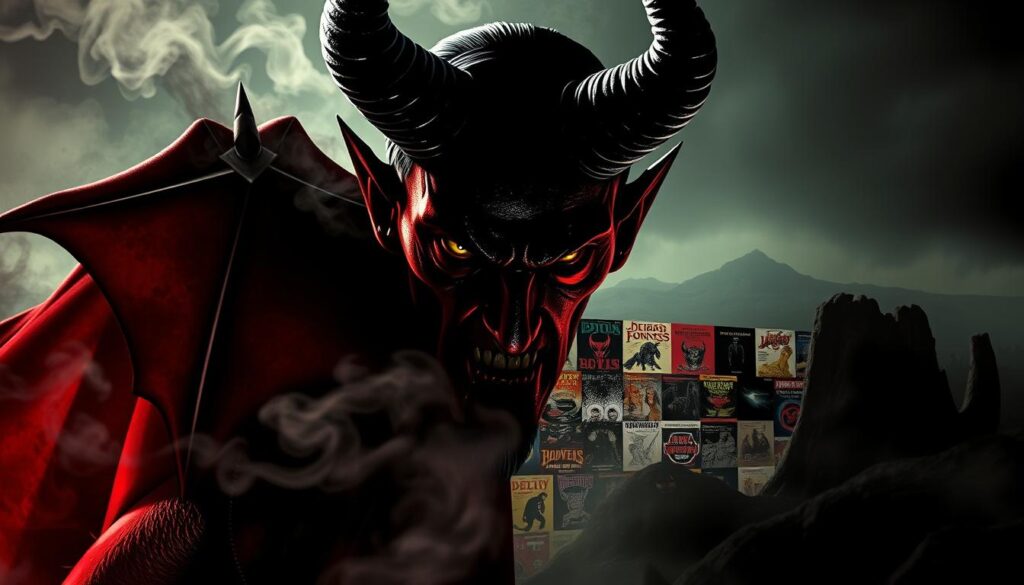
Films like The Witch, Lucifer TV series, and Hereditary explore the Devil’s role in storytelling. These works often portray this figure as a symbol of rebellion, chaos, or transformation. Similarly, the NFT art movement has sparked controversy with its demonic motifs, pushing boundaries in digital creativity.
Literature also delves into this theme. Comparing Paradise Lost to Good Omens reveals how books interpret the Devil’s duality. One portrays him as a tragic hero, while the other uses humor to explore his role in the world.
Lil Nas X’s “Montero” video is a case study in modern symbolism. It blends religious imagery with themes of self-acceptance, challenging traditional narratives. This bold approach highlights how artists use the Devil to provoke thought and spark conversation.
“Art is the lie that enables us to realize the truth.” – Pablo Picasso
By the end of this exploration, it’s clear that the Devil remains a powerful cultural figure. Whether in music, film, or literature, his presence continues to inspire and challenge, reflecting humanity’s ongoing struggle with temptation and transformation.
Conclusion: Embracing Growth Beyond Temptation
Breaking free from entrapment is a journey of self-discovery and empowerment. By synthesizing key strategies—like shadow work, affirmations, and community rituals—you can reclaim your power and transform your life. The “Phoenix Cycle” framework offers a renewal path, turning weakness into strength and fear into growth.
One inspiring story involves a 60-day transformation journal. Through daily reflections and actionable steps, the writer overcame toxic patterns and embraced a healthier mindset. This proves that change is possible with dedication and the right tools.
Emerging tarot trends, like AI interpretations and holographic decks, are reshaping how we engage with these ancient symbols. These innovations make tarot more accessible, offering fresh insights for modern seekers.
Ready to start your journey? Join the 30-Day Devil Card Challenge. Over time, you’ll uncover hidden chains and build a stronger, more authentic self. Embrace growth beyond temptation and step into a brighter world of possibilities.

